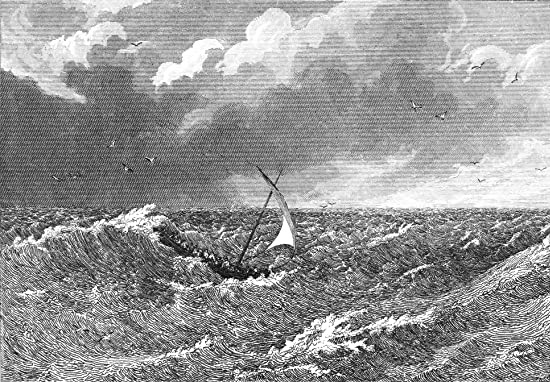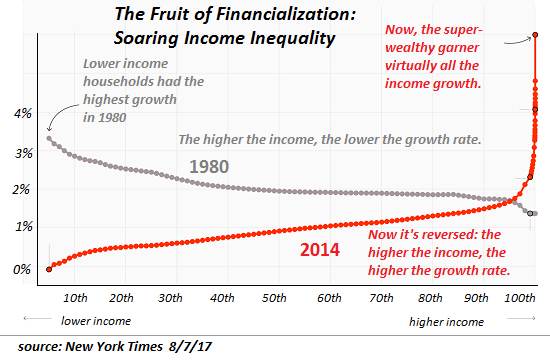No Wonder the Market Is Skittish
The equity, real estate and bond markets all rode the coattails of the Fed's ZIRP and easy-money liqudiity
tsunami for the past 13 years. As those subside, what's left to drive assets higher?
No wonder the market is skittish:
1. Every time the Federal Reserve began to taper quantitative easing / open spigot of liquidity over the past decade,
reduce its balance sheet or raise rates from near-zero, the market plummeted ("taper tantrum") and the Fed stopped
tightening and returned to easy-money expansion.
2. Now the Fed is boxed in by inflation--it can't continue the bubblicious easy-money policies, nor does it have
any room left to lower rates due to its pinning interest rates to near-zero for years.
3. So market participants (a.k.a. punters) are nervously wondering: can the U.S. economy and the Fed's asset bubbles survive
higher rates and the spigot of liquidity being turned off?
4. The market is also wondering if the economy can survive the pricking of the "everything" asset bubbles in stocks,
bonds, real estate, etc. as interest rates rise and liquidity is withdrawn. What's left of "growth" once the top 10%
no longer see their wealth expand every month like clockwork?
5. The unprecedented expansion of asset valuations driven by expansions of credit and liquidity (i.e. low-cost credit chasing
scarce assets) has greatly increased the wealth of the top 10% (especially the wealth of the top 0.1% and top 1%).
Since the top 10% collect about half of all income and account for roughly half of all consumer spending, the "wealth effect"
generated by ever-rising asset valuations has underpinned "growth" in both asset purchases and consumption.
If assets actually decline in value and the wealth effect reverses (i.e. punters feel poorer), then what will drive
expansion of capital and spending going forward?
6. The Federal Reserve and U.S. Treasury have institutionalized moral hazard, the disconnect of risk and consequence,
for America's financial elite: rather than force those who gambled and lost to absorb the losses in 2008-09,
the Fed and Treasury bailed out the too big to fail, too big to jail financial elite, establishing an unspoken
policy of encouraging the wealthiest individuals and enterprises to borrow and gamble freely, knowing they could
keep any winnings (and pay low or no taxes on the gains) and transfer any losses to the Fed and/or taxpayers.
7. This institutionalization of moral hazard combined with zero interest rate policy (ZIRP) and an open spigot of
liquidity has driven wealth and income inequality to extremes that are economically, politically and socially destabilizing.
Insider trading in the Fed and Congress has finally leached out into the public sphere, and the cozy enrichment of
the already super-wealthy has now reached extremes that invite destabilizing blowback.
8. As noted here recently, inflation is now embedded due to structural, cyclical changes in supply chains and the labor
market: rather than importing deflation, global supply chains now import inflation (higher costs) and scarcities.
After being stripmined of $50 trillion over the past 45 years, labor has finally gained some leverage to claw back a
bit of the purchasing power that has been surrendered to corporations and finance over the past two generations.
9. Inflation spirals out of control if the cost of credit (interest rates) don't rise to reward capital with
inflation-adjusted income: if inflation is 6% annually, a bond paying 1% loses 5%. This is not sustainable, for
it distorts the pricing of risk.
10. As rates rise, lower-risk bonds become more attractive than risky stocks, and capital leaves stocks for income-producing
securities. Rising rates are historically bad for stocks, so what will keep stock markets lofting higher if rates
rise, liquidity is reduced and capital exists risky stocks?
11. The stock market is overvalued by traditional measures of value, and any mean reversion will lower the market
significantly. So what's left to push risk assets higher? The only answers with any substance are: A) rising profits
due to companies having pricing power in an inflationary environment and workers getting more purchasing power so
they can afford to pay higher prices
and B) massive inflows of global capital due to perceptions of lower risk and higher returns in U.S. dollar denominated
assets. If neither transpires, there's no real support for stocks to continue lofting ever higher.
12. The equity, real estate and bond markets all rode the coattails of the Fed's ZIRP and easy-money liquidity
tsunami for the past 13 years. As those subside, what's left to drive assets higher? It's an open question, and
so skittishness is rational and prudent.
In summary: by rewarding financialization and the largest concentrations of capital at the expense of labor,
small business and productivity, the Federal Reserve and federal / state governments have made the economy and society
precariously dependent on asset bubbles, corruption (pay to play politics) and financial trickery. The only
real foundation for growth is to widen the distribution of gains in productivity, shift the gains from capital to
labor and reward small-scale investment in productivity gains rather than funnel all the gains into
asset bubbles and financialized casinos that enrich the top 0.1% at the expense of the nation and its people.


My new book is now available at a 20% discount this month:
Global Crisis, National Renewal: A (Revolutionary) Grand Strategy for the United States (Kindle $8.95, print $20)
If you found value in this content, please join me in seeking solutions by
becoming
a $1/month patron of my work via patreon.com.
Recent Videos/Podcasts:
Charles Hugh Smith on Why Many are Resigning From Their Jobs (35 minutes, with Richard Bonugli)
My recent books:
Global Crisis, National Renewal: A (Revolutionary) Grand Strategy for the United States
(Kindle $9.95, print $25)
Read Chapter One for free (PDF).
A Hacker's Teleology: Sharing the Wealth of Our Shrinking Planet
(Kindle $8.95, print $20,
audiobook $17.46)
Read the first section for free (PDF).
Will You Be Richer or Poorer?: Profit, Power, and AI in a Traumatized World
(Kindle $5, print $10, audiobook)
Read the first section for free (PDF).
Pathfinding our Destiny: Preventing the Final Fall of Our Democratic Republic
($5 Kindle, $10 print, (
audiobook):
Read the first section for free (PDF).
The Adventures of the Consulting Philosopher: The Disappearance of Drake
$1.29 Kindle, $8.95 print);
read the first chapters
for free (PDF)
Money and Work Unchained $6.95 Kindle, $15 print)
Read the first section for free
Become
a $1/month patron of my work via patreon.com.
NOTE: Contributions/subscriptions are acknowledged in the order received. Your name and email remain confidential and will not be given to any other individual, company or agency.
|
Thank you, Betty W. ($100), for your outrageously generous contribution to this site -- I am greatly honored by your steadfast support and readership. |
Thank you, Robert J. ($108), for your outrageously generous contribution to this site -- I am greatly honored by your steadfast support and readership. |
|
|
Thank you, Michael W. ($12), for your most generous contribution to this site -- I am greatly honored by your support and readership. |
Thank you, Stephen B. ($15), for your much-appreciated generous contribution to this site -- I am greatly honored by your support and readership. |


























